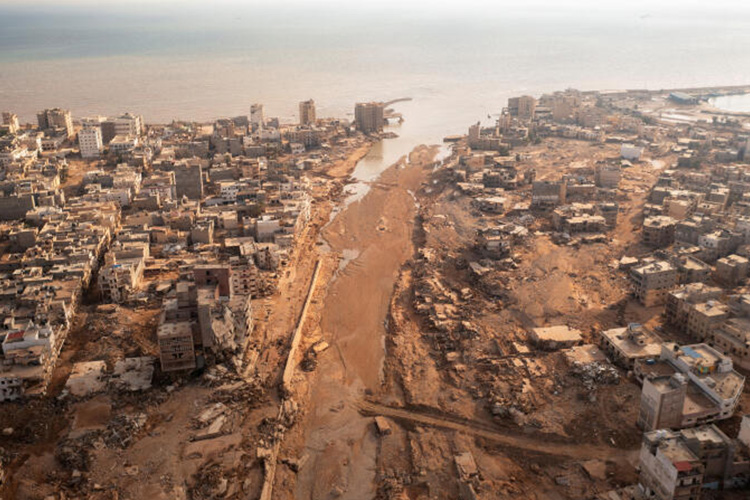
The dams in Derna breaking caused the city to be washed away with the flood waters, leaving behind thousands of displaced citizens. photo by Ayman Al-Sahili
Floods have ravaged Libya, leaving the country in ruins while people search for who is at fault.
On September 9, Storm Daniel passed through Libya, causing two dams to become overwhelmed with water and collapse. This resulted in mass destruction of the country due to effects from previous floods. The death toll has continued to rise, with over 11,000 fatalities and 10,000 people stated to be missing.
Storm Daniel was a Mediterranean hurricane, which is informally referred to as a medicane. A medicane is comparable to hurricanes and typhoons, but can develop over cooler waters. This storm also impacted other Mediterranean countries such as Greece, Turkey, and Bulgaria. However, the effects of Storm Daniel were felt most heavily in Libya.
The city of Derna, which is located near the coast of Libya, was the primary region impacted. Both of the dams broke inside the city, sending one billion cubic feet of water into the already flooded area. As a result, 891 buildings were completely destroyed, 211 buildings were partially destroyed, and about 398 buildings became submerged in mud.
However, this devastating situation could have been prevented if officials had tended to the problem when it first occurred. According to NBC News, “the dams suffered major damage in a strong storm that hit the region in 1986, and more than a decade later, a study commissioned by the government revealed cracks and fissures in their structure.” However, reports on the dam’s weakening situation piled up while restoration efforts either failed or were abandoned due to the civil war. Many survivors have been quick to blame the government, calling them corrupt as the country’s infrastructure and public services have been falling apart and neglected since the civil war in 2011.
In addition, though the Libyan government originally announced plans to evacuate the area surrounding the dam, an emergency committee imposed a curfew that countered the citizens’ attempts to leave. This lack of organization is partially to blame for the casualties of the Libyan floods.
Following the floods, the absence of government initiative led citizens to protest. Some protests have even turned violent, such as when the house of Derna’s now ousted mayor was set on fire by hundreds of people. Al-Sediq al-Sour, Libya’s top prosecutor, has taken action as well. He ordered the arrest of eight officials including officials from the Water Resources Authority and Dams Management Authority.
Currently, organizations such as the International Federation of the Red Cross and Red Crescent Societies (IFRC) and the Libyan Red Crescent Society (LRCS) are asking for assistance meeting the displaced citizens’ needs. According to IFRC, this includes “clean water, sanitation, cash assistance, and crucially, psychosocial support.” With many people losing one or more family members, there is a large focus on holistic psychosocial support which promotes the wellbeing of an entire person, not just their mental health needs. Furthermore, the LRCS is providing aid and shelter for those in need.
Despite the devastation caused by the floods, there is one unique positive that can be found: the destruction revealed new archeological remains. The waters damaged Cyrene, an ancient Greek city. Although a few of the building ruins now threaten to collapse, a water system that dates back to the Roman era is now visible, which provides further historical insight to the ancient city.
Libya is still facing the effects of the destruction and could use global support. The nation is collecting money to rebuild their infrastructure while trying to find ways to fill the gaps of their losses. Although the situation is currently in shambles, each day there are small improvements towards returning the city to stability.